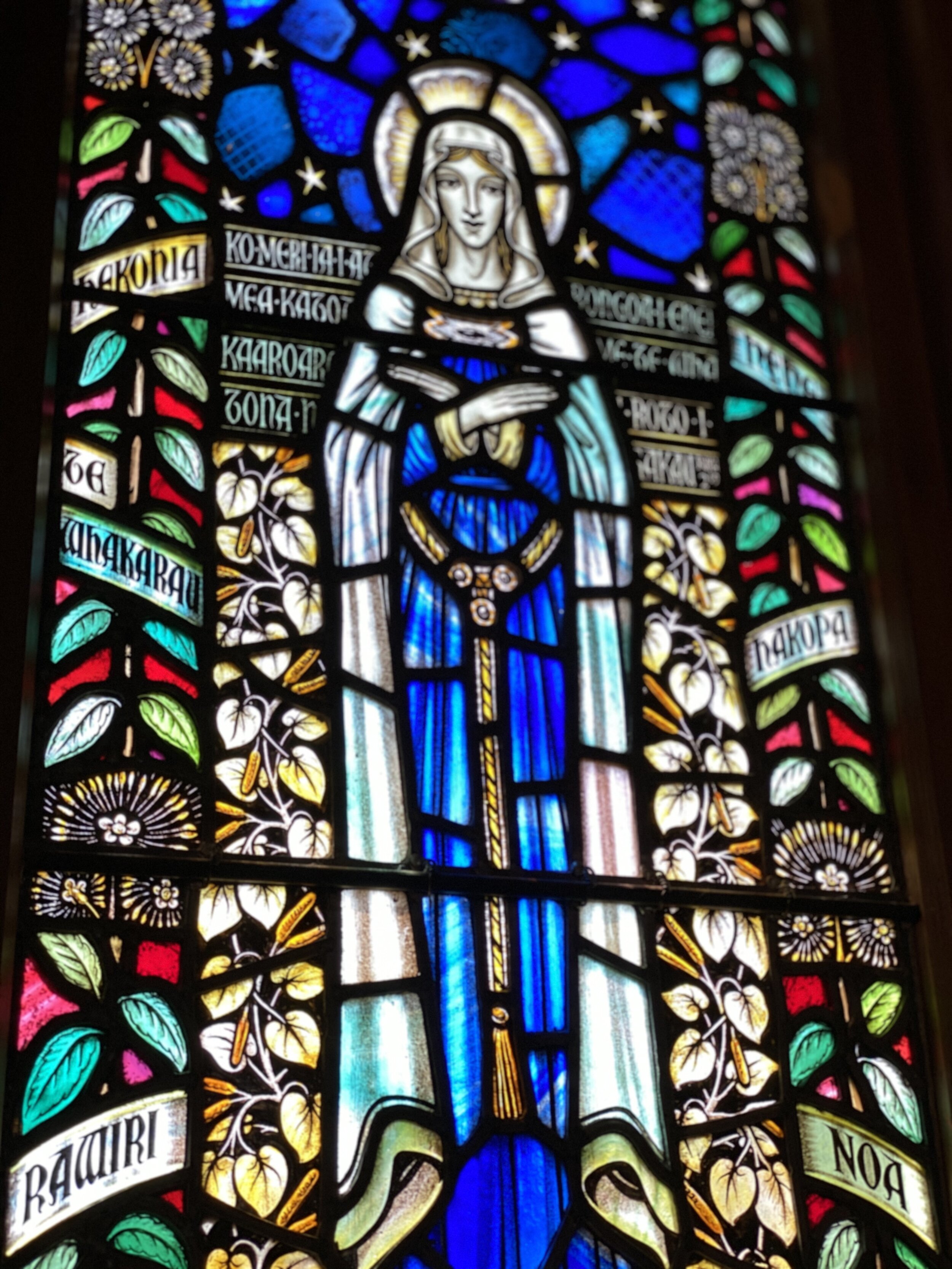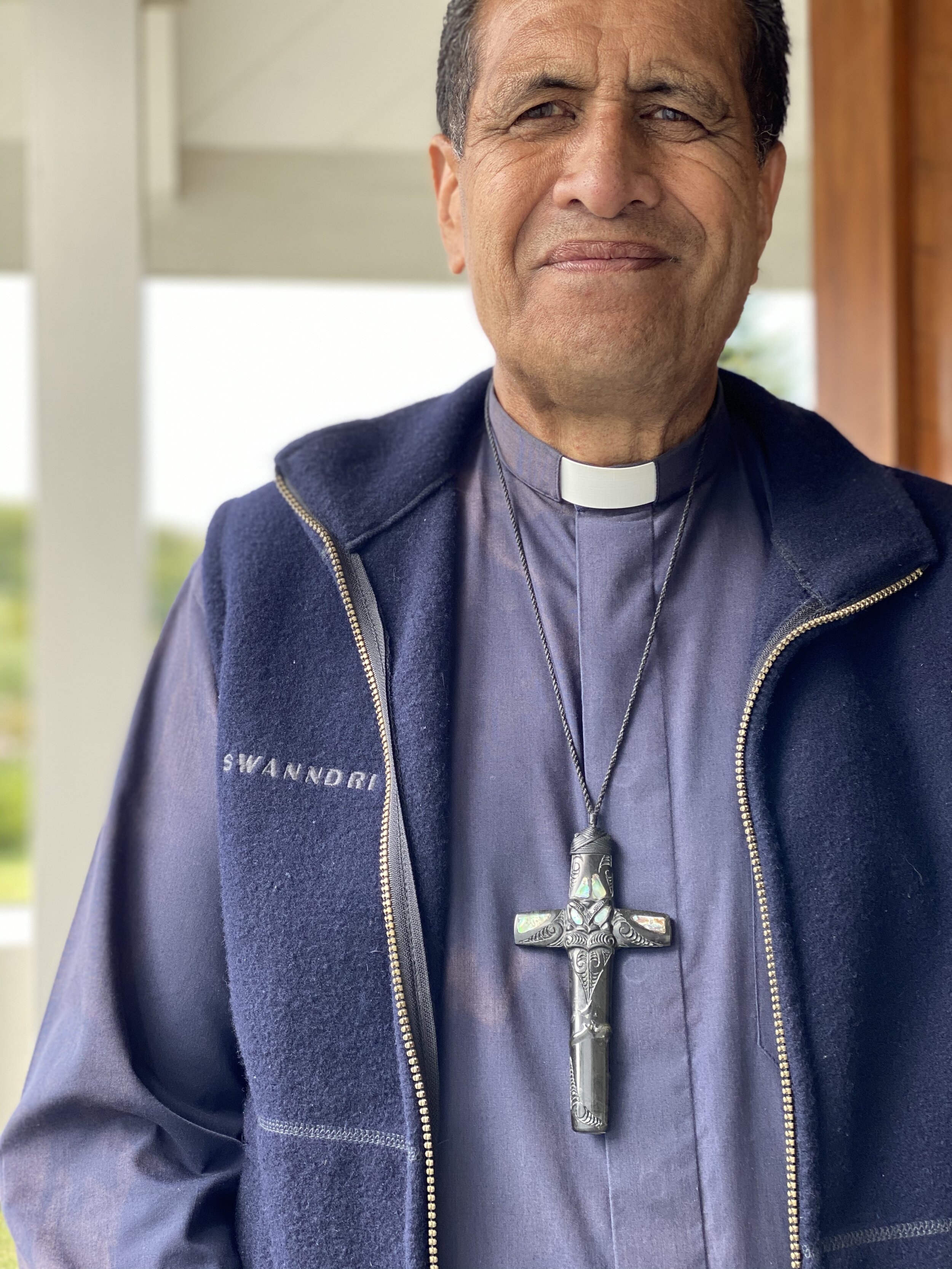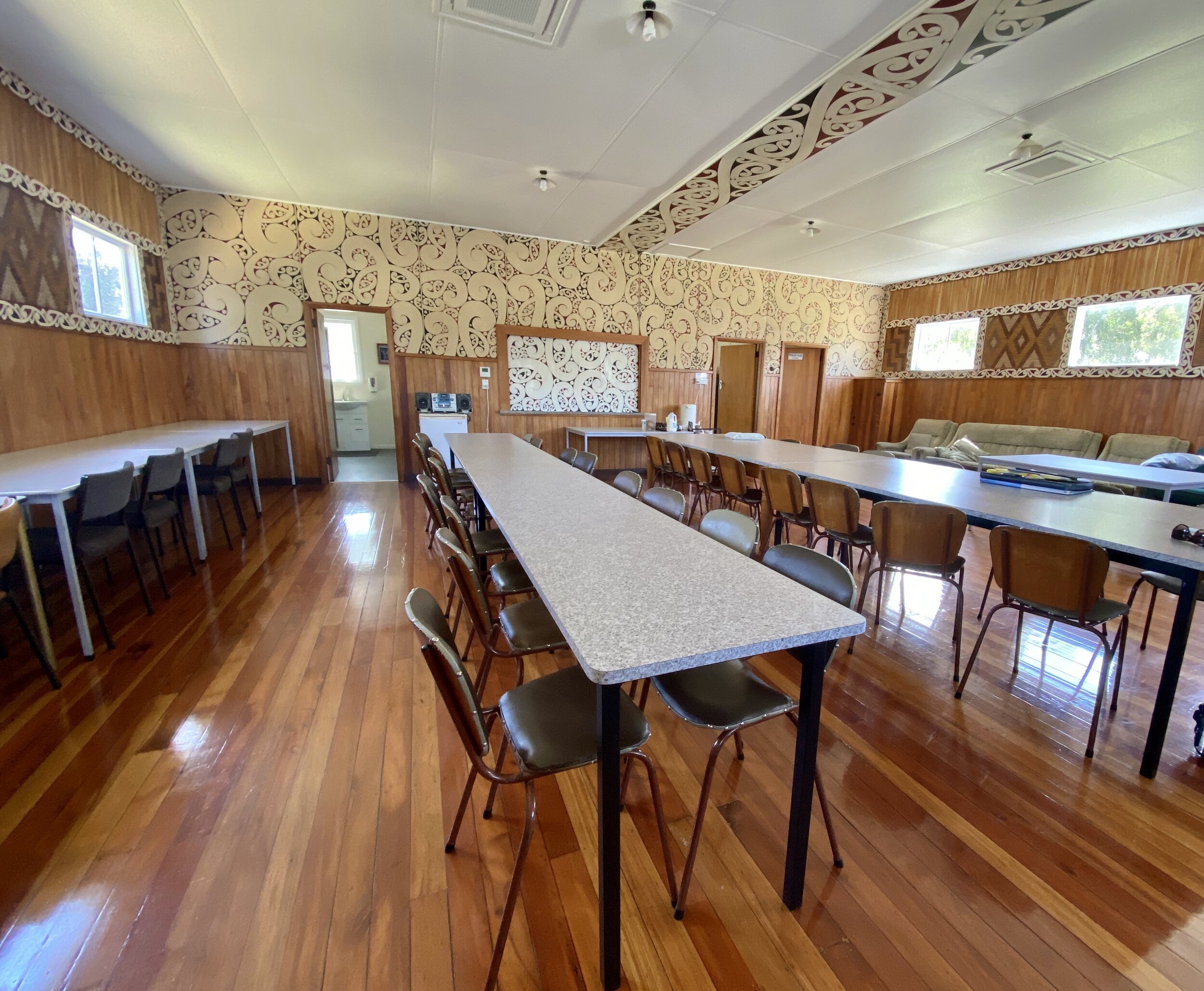In safe hands: the story of conserving Pūtiki church in Whanganui
A Whanganui community has taken a hands-on approach to conserving its stunning Category 1 church
Left to right, Pūtiki church restoration trust volunteers Gail Imhoff, Margaret Tauri, Huia Kirk (image by Jacqui Gibson).
Frankly, it’s hard to say who in the Pūtiki church community put in the most elbow grease.
Was it the volunteers in high-vis jackets who skilfully touched up dozens of ornately painted kōwhaiwhai panels while teetering on scaffolding erected metres above the ground?
Or was it the industrious team of cooks who turned out a tasty, near-constant supply of boil-ups, stews, trifles and jellies?
Put the question to church trustee and self-titled whip-cracker Huia Kirk and she’ll throw her hands up and declare it an even tie.
“They were at it five days a week for six and a half months from six in the morning until four in the afternoon. You’d have to say it was an outstanding effort all round.”
The effort to which Huia refers is the final stage in a 10-year restoration project that’s breathed new life into St Paul’s Memorial Church, known locally as Pūtiki church, a Category 1 building in the Whanganui township of Pūtiki.
Back in 2009 the historic Anglican church had fallen on hard times. The roof was leaking. Water stains discoloured the walls. The faint smell of rotting carpet could be detected and the pīngao strands that held the church’s beautifully woven tukutuku panels together were starting to unravel.
The Pūtiki congregation of around 40 people stood to lose a much-loved place of worship, while New Zealand stood to lose a one-of-a-kind church richly decorated in the Māori arts and crafts tradition.
Something had to give.
“We didn’t know exactly what was needed, but we knew we needed to do something or we’d lose it,” explains Huia over a cup of tea inside the Pūtiki Parish Hall.
Following advice from Heritage New Zealand contacts in Whanganui, Huia set up the restoration trust, became chair and set about fundraising for repairs.
The trust’s first task was to commission a conservation report from DLA Architects to identify the issues and recommend ways to address them.
Written by conservation specialists (the late) Wendy Pettigrew, Bruce Dickson and Dean Whiting (now Heritage New Zealand Director Kaiwhakahaere Tautiaki Taonga and Kaupapa Māori), the 2011 report recommended extensive renovations to the building’s interior and exterior.
It found the roof and electrical wiring needed replacing, the external walls needed painting, and new paving, insulation, fire protection and heating had to be installed.
Four years down the track, with $200,000 spent, the trust was ready to bring its efforts indoors.
Margaret Tauri, trust secretary, explains: “We didn’t want to contract out the second phase like we had the first. It wasn’t about trying to scrimp and save money by doing it ourselves – conserving the interior is what got us excited. That’s what we all wanted to be part of.”
All up, around 30 people volunteered in the project’s second phase, which included the renovation of both the church and parish hall interiors.
The Venerable Bernard Broughton opened the project with a karakia and oversaw the project tīkanga. Dean Whiting and Pouarahi Traditional Arts Jim Schuster advised volunteers on technique and sourced all-important materials such as kiekie, harakeke, pīngao and pāua shell.
Tutors and students from Te Wānanga o Aotearoa in Whanganui repaired original tukutuku panels.
Meanwhile, locals scrambled up scaffolding to repair the kākaho wall and ceiling panels and touch up decorative kōwhaiwhai rafters originally painted by Oriwa Tahupotiki Haddon and Jack Kingi.
Some volunteers got busy making kai in the parish hall kitchen, whipping up crowd favourites such as fruit pie and custard, roast pork and apple sauce and the weekly fish dish (reportedly a Friday favourite).
Others spent hours carefully cleaning 80-year-old whakairo with toothbrushes and soft cloths.
One volunteer took care of workplace acoustics by playing a kōauau as people worked around him.
Looking back, Margaret and Huia agree that a lot of perseverance, skill and aroha has gone into the restoration project.
“Sometimes people were quiet in their work and full of concentration. Other times the talk would fly about, punctuated by sudden bursts of laughter,” says Huia.
“I think one of the things I most enjoyed was the fellowship and listening to people strengthen their bonds to one another and to this place.”
The Venerable Bernard Broughton of Pūtiki church in Whanganui (image by Jacqui Gibson).
Both Huia and Margaret have strong personal ties to Pūtiki. Huia, of Te Āti Haunui-a-Pāpārangi descent, traces her whakapapa to the original people of the Whanganui River. She is well versed in the community’s history and, at 82, still hosts tours of Pūtiki church for the local tourism office.
In 1938 she was one of the first babies baptised in the church, a year after it was consecrated.
Margaret’s late husband John Tauri was a descendant of Ngāti Tūwharetoa rangatira Wiremu Eruera Te Tauri, who brought Christianity to Pūtiki in 1836.
Every Sunday both women attend the bilingual church service at Pūtiki – Margaret as a lay reader and Huia in the congregation.
Dean Whiting, whose late father, artist Cliff Whiting, decorated Pūtiki Parish Hall in 1972, says the community’s deep connection to the church is part of what makes it special.
“People’s ties to Pūtiki church are intergenerational. It’s amazing.
“Personally, I remember coming here with Dad as a kid. Places like the Pūtiki church only really survive with a connection like that; where the connection to the community is hands-on.”
Huia and Margaret believe Pūtiki church is relevant to all New Zealanders. It’s among the most highly ornamented churches in New Zealand, for starters, says Huia, and it is one of only a few churches associated with the Māori arts and crafts revival kickstarted by Sir Āpirana Ngata in 1927.
“Almost every element of the interior reflects something of the customary Māori art form,” she says.
“Walk inside and you’ll see everything from geometric-patterned tukutuku panels that line the upper walls and roof trusses to the ceiling painted with kōwhaiwhai designs representing Whanganui bush flora.”
“Walk inside and you’ll see everything from geometric-patterned tukutuku panels that line the upper walls and roof trusses to the ceiling painted with kōwhaiwhai designs representing Whanganui bush flora.”
But it also tells an important story, she says, about the arrival of the Anglican faith in New Zealand.
On the outside, Pūtiki church is every bit the modest neo-Gothic building designed and built by Arthur J Cutler in 1937 (image by Jacqui Gibson).
Built in 1937, the church was the fifth to serve the people of the Pūtiki Mission Station, an early Christian mission established in 1840 on land that had been gifted by local rangatira. As such, adds Huia, the modest neo-Gothic building designed and built by Arthur J Cutler is a symbol of the church’s enduring legacy at Pūtiki.
According to a Heritage New Zealand report by Blyss Wagstaff, St Paul’s Memorial Church also reflects a uniquely Māori take on Christianity.
Published in 2019, the report says that the Māori community “imbued the very fabric of the building and its contents with their culture, traditions, artistry and memories”.
And it’s this rich combination of factors that makes this church one of New Zealand’s most important historic churches.
So, when can people visit Te Anaua Street in Pūtiki and see it for themselves?
“People can sign up for a guided tour at Whanganui’s i-SITE visitor centre in town or they can drop in on a Sunday morning,” says Huia.
“The doors are open every Sunday at 9am. Attend a service with us, then come next door to the parish hall for a cup of tea and a biscuit.
“We’re a pretty good bunch, with a pretty good sense of humour and way about us,” she adds. “That way, you’ll see our special country church with people in it, enjoying it. You’ll see it as it really is.”
THE VISION OF SIR APIRANA NGATA COMES TO PUTIKI
The St Paul’s Memorial Church and Parish Hall communities in Pūtiki can thank Sir Āpirana Ngata for the stunning buildings that occupy their township.
The interior decoration of both buildings reflects the vision of the Māori leader, politician and scholar who wanted to revive Māori decorative arts, such as fine finger weaving and traditional carving, to improve the social and economic wellbeing of Māori.
In 1927 Sir Āpirana opened the School of Māori Arts and Crafts in Rotorua and commissioned its students to decorate approximately 50 buildings throughout New Zealand, including wharenui and whare karakia.
Many significant artists worked on St Paul’s, including nationally renowned master carver Pineamine Taiapa, who directed the whakairo carvers. These included Hoani (John) Metekingi from Pūtiki, who carved the church’s memorial font and baptistery canopy.
Years later, in 1972, Dr Cliff Whiting, Māori artist and Whanganui district advisor on Māori arts and crafts, drew on the vision of Sir Āpirana to decorate the Pūtiki Parish Hall, applying traditional Māori artforms to the hall’s walls and simultaneously giving those same artforms a modern twist.
This story was first published in Heritage New Zealand magazine.










